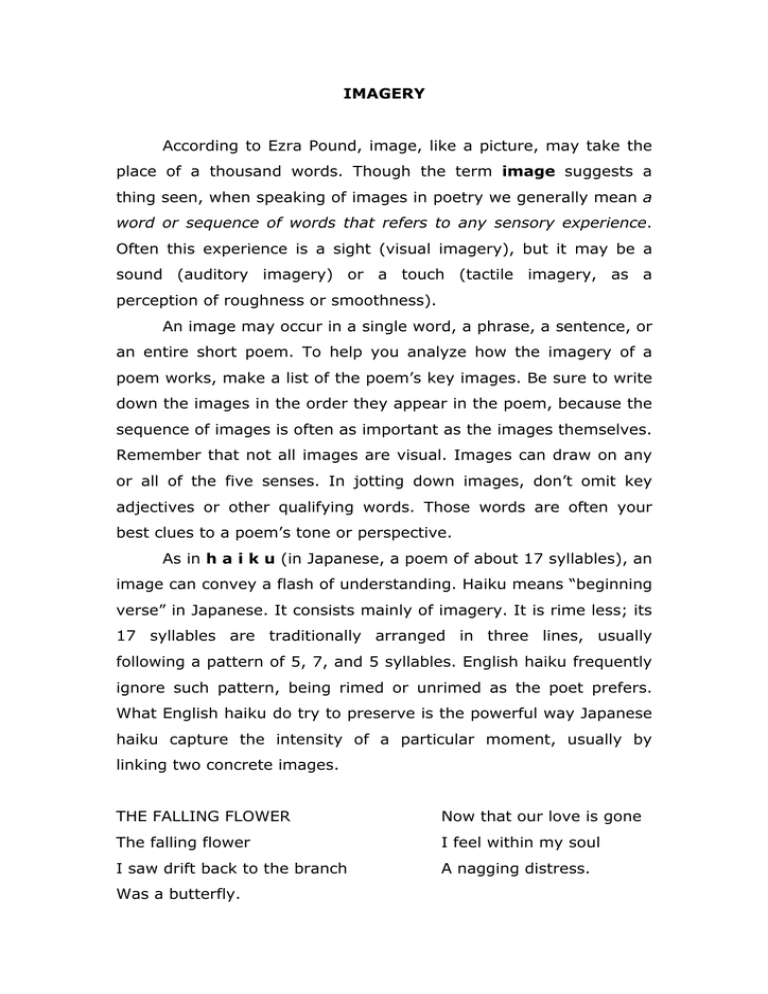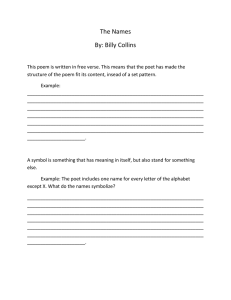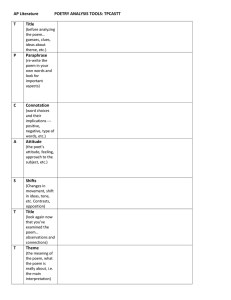IMAGERY According to Ezra Pound, image, ... image
advertisement

IMAGERY According to Ezra Pound, image, like a picture, may take the place of a thousand words. Though the term image suggests a thing seen, when speaking of images in poetry we generally mean a word or sequence of words that refers to any sensory experience. Often this experience is a sight (visual imagery), but it may be a sound (auditory imagery) or a touch (tactile imagery, as a perception of roughness or smoothness). An image may occur in a single word, a phrase, a sentence, or an entire short poem. To help you analyze how the imagery of a poem works, make a list of the poem’s key images. Be sure to write down the images in the order they appear in the poem, because the sequence of images is often as important as the images themselves. Remember that not all images are visual. Images can draw on any or all of the five senses. In jotting down images, don’t omit key adjectives or other qualifying words. Those words are often your best clues to a poem’s tone or perspective. As in h a i k u (in Japanese, a poem of about 17 syllables), an image can convey a flash of understanding. Haiku means “beginning verse” in Japanese. It consists mainly of imagery. It is rime less; its 17 syllables are traditionally arranged in three lines, usually following a pattern of 5, 7, and 5 syllables. English haiku frequently ignore such pattern, being rimed or unrimed as the poet prefers. What English haiku do try to preserve is the powerful way Japanese haiku capture the intensity of a particular moment, usually by linking two concrete images. THE FALLING FLOWER Now that our love is gone The falling flower I feel within my soul I saw drift back to the branch A nagging distress. Was a butterfly. Robert Bly (1962) DRIVING TO TOWN LATE TO MAIL A LETTER It is a cold and snowy night. The main street is deserted. The only things moving are swirls of snow. As I lift the mailbox door, I feel its cold iron. There is a privacy I love in this snowy night. Driving around, I will waste more time. T.E. Hulme (about 1910) IMAGE Old houses were scaffolding once and workmen whistling. 1. The example of olfactory imagery (the sense of smell) The atmosphere is not a perfume, it has no taste of the distillation, it is odorless, It is for my mouth forever, I am in love with it, I will go to the bank by the wood and become undisguised and naked, I am mad for it to be in contact with me. The smoke of my own breath, (Whitman’s Songs of Myself) 2. The example of gustatory imagery (the sense of taste) Drinking cold snow-water from a tin cup Looking down for miles…. (Gary Snyder’s Mid August at Soudough Mountain Lookout) 3. The example of kinesthetic imagery (the sense of movement) the startled little waves… (Browning’s Meeting at Night) Exercise: Write a brief account of your experience in reading the poems above by paying special notice to their imagery. What images strike you, and why?




